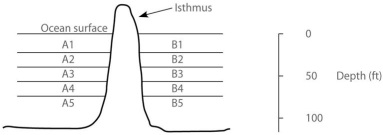The next few questions refer to the following description.
In the ocean, on either side of the Isthmus of Panama, are 30 species of snapping shrimp; some are shallow-water species, others are adapted to deep water. There are 15 species on the Pacific side and 15 different species on the Atlantic side. The Isthmus of Panama started rising about 10 million years ago.
In the following figure, the isthmus separates the Pacific Ocean on the left (side A) from the Atlantic Ocean on the right (side B) . The sea water on either side of the isthmus is separated into five depth habitats (1-5) , with 1 being the shallowest.

-The Panama Canal was completed in 1914, and its depth is about 15 metres. After 1914, snapping shrimp species from which habitats should be most likely to form hybrids as the result of the canal?
Definitions:
Neurotransmitter Levels
The concentrations of chemicals in the brain that transmit signals across synapses between neurons, influencing mood, thought, and behavior.
First-generation Antipsychotic
A class of drugs used to treat psychiatric conditions, particularly schizophrenia, characterized by their dopamine receptor antagonism.
Second-generation Antipsychotic
A class of drugs used to treat psychiatric conditions, generally considered to have fewer side effects than first-generation antipsychotics.
Muscle Tremors
Involuntary, rhythmic muscle contractions that result in shaking movements in one or more parts of the body.
Q4: With respect to the sickle-cell allele, what
Q6: A researcher has used in vitro mutagenesis
Q23: H1N1 was declared _ in June 2009.<br>A)an
Q23: Absence of bicoid mRNA from a Drosophila
Q42: Which of the following is characteristic of
Q52: Which of the following is true of
Q53: Researchers have successfully inserted this gene into
Q70: Dogs (Canis lupus familiaris)and gray wolves (Canis
Q75: Which of the following mutations would be
Q83: In the United States, the parasite that